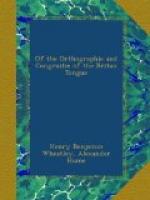8. In this diphthong we co_m_mit a grosse errour, saving better judgement, spelling how, now, and siklyk with w, for if w be (as it sal appear, quhen we cum to the awn place of it) a consonant, it can noe wayes coalesse into a diphthong sound, sik as this out of controversie is.
9. U, the last of this rank, the south, as I have said in the latin sound of it, pronu_n_ces eu, we ou, both, in my simple judgement, wrang, for these be diphthong soundes, and the sound of a voual sould be simple. If I sould judge, the frensh sound is neerest the voual sound as we pronu_n_ce it in mule and muse.
10. Of it we have a diphthong not yet, to my knawlege, observed of anie; and, for my awn parte, I am not wel resolved neither how to spel it, nor name it. Onelie I see it in this, to bou, a bow. I wait not quhither I sould spel the first buu, or the last boau. As, for exemple, if Roben Hud wer nou leving, he wer not able to buu his aun bou, or to bou his aun boau. And therfoer this with al the rest, hou be it in other I have more for me, I leave to the censure of better judgement.
OF CONSONANTES.
Cap. 4.
1. This for the vouales, and diphthonges made of them without the tuiches of the mouth. Now followe the consonantes.
2. A consonant is a letter symbolizing a sound articulat that is broaken with the tuiches of the mouth.
3. The instrumentes of the mouth, quherbe the vocal soundes be broaken, be in number seven. The nether lip, the upper lip, the outward teeth, the inward teeth, the top of the tongue, the midle tong, and roof of the mouth. Of these, thre be, as it were, ha_m_meres stryking, and the rest stiddies, kepping the strakes of the ha_m_meres.
4. The ham_m_eres are the nether lip, the top of the tongue, and the midle tongue. The stiddies the overlip, the outward teeth, the inward teeth, and the roofe of the mouth.
5. The nether lip stryking on the overlip makes b, m, p, and on the teeth it makes f and v.
6. The top of the tongue stryking on the inward teeth formes d, l, n, r, s, t, and z.
7. The midle tongue stryking on the rouf of the mouth formes the rest, c, g, k, j, q, and x, and so we have 18 consonantes borrowed of the latines.
8. These they borrow al from the greekes, saving j and v, quhilk our age soundes other wayes then it seemes the romanes did; for Plutarch, more then 100 yeeres after Christ, expressing the sound q_uhi_lk they had in his tyme, symbolizes them neerar the sound of the vouales quherof they are maed then now we sound them in latin, for in Galba he symbolizes junius vindex, +iounios ouindex+, q_uhi_lk, if then it had sounded as now we sound it, he sould rather have written it with gamma and beta, +gounios bindex+.




